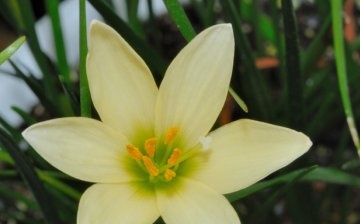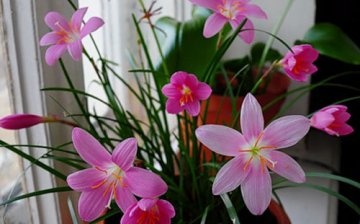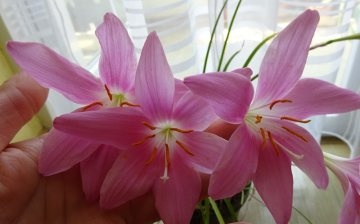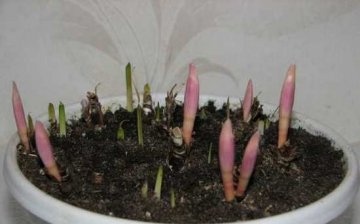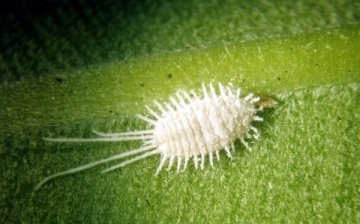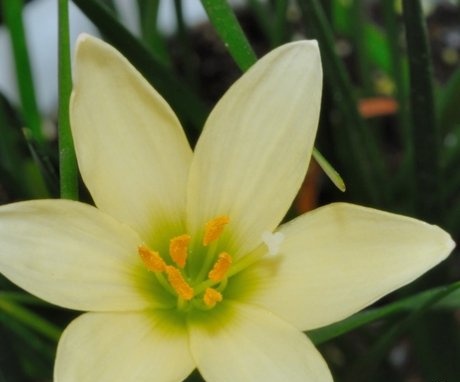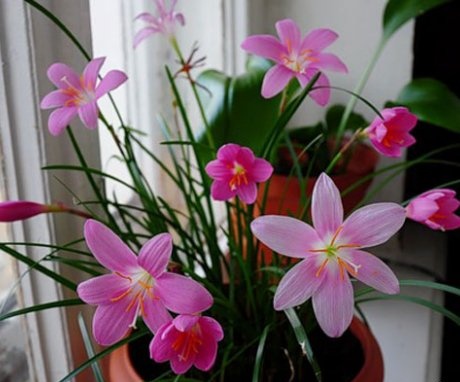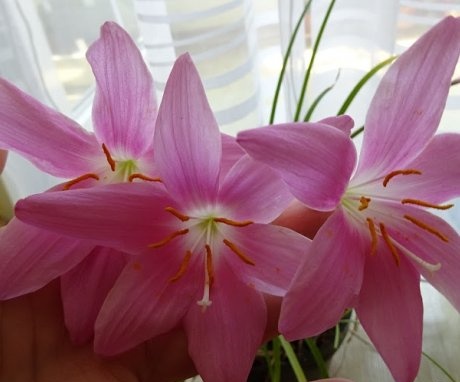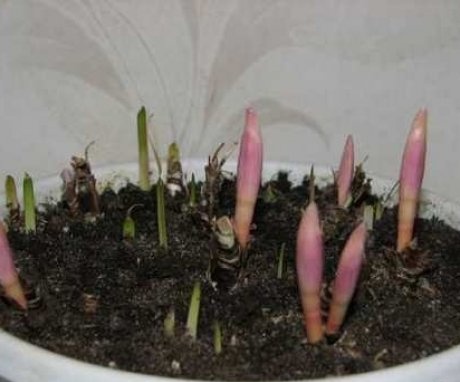Zephyranthes: proper flower care
Zephyranthes is a native of Central and South American countries. The flower owes its name to the mythical god Zephyr, who controls the westerly wind, which is the source of numerous tropical rains. It is at this time that zephyranthes suddenly blooms. At first, these are single flowers, similar to lilies, which eventually grow into whole groups.
It is because of the suddenness of flowering that the plant was popularly called "upstart". And because of the shape of the flowers, marshmallows are called water lilies or domestic daffodils. Among botanists, there is a Greek name consisting of two words "zephyr" and "anthos", which literally translates the flower of the west wind. You can also find such translation options as lily (flower) of rain or lily of the fairy.
Content:
- What does an indoor flower look like?
- Optimal conditions for zephyranthes
- How to properly care for a flower
- Features of reproduction and plant transplantation
- What diseases and pests are zephyranthes susceptible to?
What does an indoor flower look like?
Duration flowering one bud is small and lasts no more than two days, but the faded flower is immediately replaced by a new one or several at once. This alternation lasts for two months, which gives the impression of continuous flowering.
Zephyranthes belongs to small-bulbous perennials.
Linear leaves looking in different directions grow from the bulb and have a long narrow shape. Small bulbs, similar to bird eggs, no more than three and a half centimeters in diameter. Crocus-shaped or star-shaped flowers bloom one at a time on long (20-30cm) peduncles and can be white, pink, yellow, reddish or two-tone. Zephyranthes is a low-poisonous plant, so you need to keep it away from children and pets, and when leaving, take precautions and wear protective clothing.
The genus zephyranthes is distinguished by its rapid growth rates and has about 40-45 species:
- White flowering. From this category, snow-white and ataman zephyranthes gained particular popularity. In appearance, they are similar to each other, but bloom at different times. Snow-white flowers bloom in mid-summer and delight with flowers until mid-autumn, and atamans begin to bloom in early spring. Therefore, with a well-chosen tandem, flowers will decorate the interior all spring, summer and half of autumn.
- Yellow. Golden and lemon marshmallows deserve special attention. They also have a similar appearance and different flowering times. Golden flowers release flowers in winter, and lemon flowers in summer. For these varieties, lighting is of particular importance, because even a light shade can reduce the decorative effect of the plant. They are also more demanding to care for.
- Pink. Particularly noteworthy are the large-flowered marshmallows, which are called "Powerful kick". Flowering occurs from mid-spring to mid-summer. At the same time, they form large inflorescences up to 10 cm in diameter, with delicate pink petals and a yellow center.
- Bicolor. Flowers of multi-colored marshmallows are painted in different colors.Moreover, at the base, they are more saturated and have a brownish or reddish color, and at the edges the petals are whitish or pinkish. The size of the flower heads reaches seven centimeters.
Given that different varieties bloom at different times of the year, but they do not have any special differences in care, you can combine flowers of different varieties in one pot. Thus, the effect of continuous year-round flowering is achieved.
Optimal conditions for zephyranthes
Despite its tropical roots, Zephyranthes thrives in a pot on a windowsill. The main thing to remember is that under natural conditions the plant prefers to grow in the coastal zone of rivers, and therefore requires maintaining the required moisture level. To do this, you need to regularly irrigate the plant and, if necessary, spray it.
Spraying is carried out only if the air in the room is very dry.
Otherwise, it is an undemanding culture that will not be a hassle. During the summer season, plants can be moved outdoors, but placed so that rain does not fall on them. In winter, the optimum temperature is 9-10 degrees and moderate illumination. In the summer season, the temperature should be at the level of 20-25 degrees, and the humidity is medium or slightly high. During flowering, it is better to place the zephyranthes in a sunny place and increase the frequency of watering.
How to properly care for a flower
Despite its unpretentiousness, when growing zephyranthes, you will need to take into account some features and follow simple rules:
- The soil, as for many indoor flowers, should be light, nutritious and have high air and moisture permeability. Therefore, the ideal soil mixture will be equal parts of sod land, rotted compost and cleaned river sand. It will be useful to add a phosphorus-containing fertilizer.
- Irrigation. Moderate watering is enough for the flower, which is carried out with the same frequency throughout the year. The frequency of irrigation is determined by the state of the soil mixture in the pot - it must be constantly moistened, but not wet. It may happen that the "upstarts" will shed their leaves - usually this happens during periods of rest. In this case, you should reduce watering so that the bulbs dry out.
- Top dressing and fertilizers. From the moment the leaves appear and until the last blooming flower, marshmallows should be fed mineral complex fertilizers for indoor flowering plants in the form of solutions.
Features of reproduction and plant transplantation
For the reproduction of zephyranthes, the method of children and seed is used:
- Reproduction with the help of children. To do this, rapidly growing babies are separated from the mother's bulb. It is worth doing this before the onset of the rest period, so that they have time to start. They are seated in individual containers for several copies.
- Seed method. This method is most suitable for planting a plant. It is also easy to implement, but to wait for flowering you need to be patient, because it will come only after a few years.
Transplant Zephyranthes should be carried out no more than once every two to three years, if there are no special indications for the procedure (rotting of the bulbs or waterlogging). But experienced gardeners recommend carrying out such manipulations annually, because the plant bulbs quickly grow and fill the pot.
The planting container should be shallow but wide to prevent stagnant water.
For this purpose, high-quality drainage is laid. During transplantation, most of the old soil is removed and new soil is added. After the event, watering should be reduced and the plant should be allowed to adapt without disturbing its movements.
What diseases and pests are zephyranthes susceptible to?
The east wind flower can infect scale insects, which show their presence with small brown plaques on leaves and stems.If nothing is done, the plant will begin to dry out and may die.
Also, the flower can be chosen by spider mites. This happens at a low humidity level. The first measures when these insects are found are the treatment of plants with a solution of soap, the plaque of which is washed off after complete drying. To get rid of these pests, the leaves should be washed with solutions of special preparations, including Actellik, Karbofos and Decis.
The most dangerous pests are amaryllis worms.
These are small white insects that infect the bulbs of the plant, feeding on their pulp. Also, these pests provoke the development of the fungus. When damaged, zephyranthes loses its decorative effect and has a weakened appearance, gradually shedding foliage. They fight this pest with systemic insecticides, during this period they reduce the abundance of irrigation. If the bulbs are severely affected, they should be destroyed.
Despite the showiness of the flower and its ability to delight with flowering all year round (with a competent combination of varieties), it is not difficult to take care of the zephyranthes. It is enough to take into account his preferences, which are similar to many houseplants.
More information can be found in the video:




